Byland Abbey
Byland Abbey is a ruined abbey and a small village in the Ryedale district of North Yorkshire, England, in the North York Moors National Park.
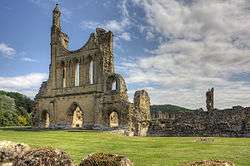 | |
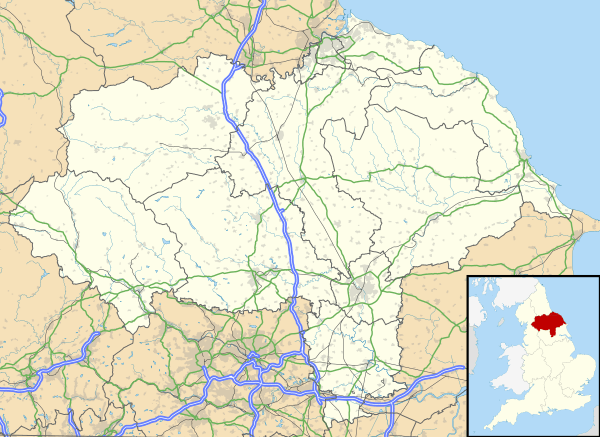 Location within North Yorkshire | |
| Monastery information | |
|---|---|
| Order | Savigniac, Cistercian 1148 |
| Established | 1155 |
| Disestablished | 1538 |
| Diocese | Diocese of York |
| People | |
| Important associated figures | Abbot Roger, Roger de Mowbray |
| Site | |
| Location | Byland, Coxwold, North Yorkshire, England |
| Coordinates | 54.2031°N 1.1592°W |
| Visible remains | substantial |
| Public access | yes |
History
It was founded as a Savigniac abbey in January 1135 and was absorbed by the Cistercian order in 1147.[1] It was not an easy start for the community who had had to move five times before settling at New Byland, near Coxwold in 1177.[2]
Its early history was marked by disputes with no fewer than four other religious establishments: (Furness Abbey, Calder Abbey, Rievaulx Abbey and Newburgh Priory).[3] However, once it had overcome this bad start, it was described in the late 14th century as "one of the three shining lights of the north".[1] Its financial success was not as great as that of places like Rievaulx, but it was famed for its sheep rearing and wool exports. Its church was said to be among the finest 12th-century churches in Europe.[4]
In October 1322, King Edward II was at Byland Abbey when the Battle of Old Byland took place. The marauding Scots caught Edward so unaware, that he fled to York leaving many precious items behind.[note 1][3][5][6]
In the late 12th century the abbey had a complement of 36 monks and 100 lay brothers, but by the time of the dissolution in November 1538, the abbey was host only to 25 monks and an abbot.[7] In 1539, its site was granted to Sir William Pickering.[8]
The site is now maintained by English Heritage[9] and is scheduled as an ancient monument by Historic England with grade I listed status.[10][11] In October 2017, the west frontage of the church, including the famed Rose Window, underwent extensive conservation work to repair water damage and to repoint the stone walls.[12]
Burials
- Mabel de Clare, d. 1204 (daughter of Roger de Clare, 2nd Earl of Hertford), wife of Nigel de Mowbray
- Roger de Mowbray (Lord of Montbray) (though some uncertainty about his final resting place)
- William de Mowbray, 6th Baron of Thirsk, 4th Baron Mowbray
- Joan of Lancaster, third daughter of Henry, 3rd Earl of Lancaster
Medieval ghost stories
One of the manuscripts owned by Byland Abbey in the Middle Ages is noted for containing a collection of twelve ghost stories. The manuscript is now London, British Library Royal MS 15 A xx, produced in the twelfth to thirteenth centuries, primarily containing a copy of the Elucidarium and some tracts by Cicero. However, in the early fifteenth century, an anonymous scribe, known in scholarship simply as 'a monk of Byland', added some extra texts, also in Latin, on previously blank pages (folios 140-43, in the body of the manuscript, and folio 163 b at the end).[13][14] These are a series of twelve ghost stories, mostly set locally, which were presumably intended for inclusion in sermons as exempla and which reflect orally circulating folklore in Yorkshire at the time. While not a major literary production in their own time, these stories have since come to be regarded as important evidence for popular belief regarding ghosts in medieval north-west Europe.[15][16][17][18]
A facsimile of the manuscript is available online,[19] the texts were edited by M. R. James,[20] and they were translated by A. J. Grant[21] (while seven are also paraphrased in English by Andrew Joynes).[22]
An example, the third story, runs in English translation as follows:
III. Regarding the spirit of Robert son of Robert de Boltebi from Killeburne, confined in a cemetery.
Remembered because the aforesaid younger Robert died and was interred in a cemetery but was wont to depart from the tomb at night and to disturb and frighten off the villagers, and the dogs of the village would follow him and bark loudly. At last the young men of the village spoke together, proposing to capture him if by any means they were able, and convening at the cemetery. But having seen him, all fled except two of them. One, called Robert Foxton, caught him as he emerged from the cemetery and laid him over the church gate, loudly and courageously shouting ‘You hold fast until I come to you’. The other replied ‘You dash quickly to the minister so that he may be conjured, since, God willing, because I have him fast, I will hang on until the arrival of the priest’. The priest of the parish indeed hurried quickly and conjured him the holy name of the trinity and by the virtue of Jesus Christ until he responded to his questions.
At that conjuration, he spoke in his guts (and not with his tongue, but as if in a large empty jar) and confessed his many crimes. When he knew these, the priest absolved him but he insisted that the aforesaid capturers would not reveal in any way his confession, and otherwise he rested in peace, having been set in order with God.
Description
Impressive remains can still be seen, in the care of English Heritage, including the lower half of a huge rose window which was the inspiration for the same window at York Minster.[23][24] An interesting feature is the preservation of some of the brightly coloured medieval floor tiles. An altar table (mensa) was also recovered, although that is now in Ampleforth Abbey, and a stone lectern base from the chapter house is the only example of its kind in Britain.[25]
Gallery
_(14776819444).jpg) Byland Abbey as depicted in The ruined abbeys of Yorkshire (1883)
Byland Abbey as depicted in The ruined abbeys of Yorkshire (1883)May2005.jpg) Byland Abbey, May 2005
Byland Abbey, May 2005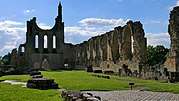 nave, the west
nave, the west nave, the east
nave, the east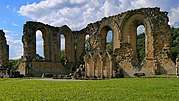 north transept
north transept cloister
cloister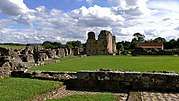 cloister and warming house
cloister and warming house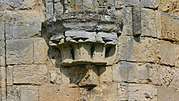 capital
capital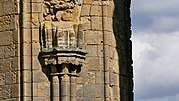 capital
capital Byland Abbey in August 2013
Byland Abbey in August 2013
See also
- Battle of Old Byland
- Wimund - English bishop, later turned pirate, was held here after his capture in the 12th century.
Notes
- Some sources say that Edward was at Rievaulx Abbey.
References
- Behrens, David (11 October 2017). "Medieval mixture replaces 20th century concrete as restorers seize 'chance of a lifetime' to preserve Byland Abbey". The Yorkshire Post. Retrieved 27 November 2017.
- Beadle, Brian (19 March 2010). "A cycle ride to Byland Abbey and Rievaulx". York Press. Retrieved 27 November 2017.
- "Houses of Cistercian monks: Byland | British History Online". www.british-history.ac.uk. Retrieved 27 November 2017.
- Ratcliffe, Roger (21 September 2010). "Great Yorkshire Walks : Discover the moors". The Yorkshire Post. Retrieved 27 November 2017.
- Clark, David (2002). Battlefield walks in Yorkshire. Wilmslow: Sigma Leisure. pp. 32–34. ISBN 1-85058-775-2.
- Trout, Thomas Frederick (1905). "XIV: The Fall of Edward II. and the Rule of Isabella and Mortimer". The history of England from the accession of Henry III. to the death of Edward III., 1216-1377. London: Longmans Green. p. 289. OCLC 63450678.
- "Byland Abbey, North Yorkshire | Educational Images | Historic England". historicengland.org.uk. Retrieved 27 November 2017.
- "History of Byland Abbey, in Ryedale and North Riding | Map and description". www.visionofbritain.org.uk. Retrieved 27 November 2017.
- "Byland Abbey | English Heritage". www.english-heritage.org.uk. Retrieved 27 November 2017.
- Historic England. "Byland Abbey Cistercian monastery: monastic precinct, water-management earthworks, enclosures, ancillary buildings and quarries (1013403)". National Heritage List for England. Retrieved 27 November 2017.
- Historic England. "Byland Abbey (Grade I) (1315790)". National Heritage List for England. Retrieved 27 November 2017.
- Darley, Karen (18 October 2017). "Work under way to restore abbey". Gazette & Herald. Retrieved 27 November 2017.
- "Detailed record for Royal 15 A XX".
- M. R. James, 'Twelve Medieval Ghost-Stories', The English Historical Review, 37 (1922), 413–422 (p. 414) doi:10.1093/ehr/xxxvii.cxlvii.
- Jacqueline Simpson, 'Repentant Soul or Walking Corpse? Debatable Apparitions in Medieval England', Folklore, 114 (2003), 389-402, doi:10.1080/0015587032000145397.
- R. N. Swanson, 'Defaming the Dead: A Contested Ghost Story from Fifteenth-Century Yorkshire', Yorkshire Archaeological Journal: A Review of History and Archaeology in the County, 82 (2010), 263-68, doi:10.1179/yaj.2010.82.1.263.
- Stephen R. Gordon, 'The Walking Dead in Medieval England: Literary and Archaeological Perspectives' (unpublished Ph.D. thesis, University of Manchester, 2013).
- Maik Hildebrandt, 'Medieval Ghosts: the Stories of the Monk of Byland', in Ghosts - or the (Nearly) Invisible: Spectral Phenomena in Literature and the Media, ed. by Maria Fleischhack and Elmar Schenkel (Peter Lang AG, 2016), pp. 13-24.
- "Royal MS 2 A XX".
- M. R. James, 'Twelve Medieval Ghost-Stories', The English Historical Review, 37 (1922), 413–22 doi:10.1093/ehr/xxxvii.cxlvii.
- A. J. Grant, 'Twelve Medieval Ghost Stories', The Yorkshire Archaeological Journal, 27 (1924), 363–79.
- Medieval Ghost Stories: An Anthology of Miracles, Marvels and Prodigies, ed. by Andrew Joynes (Boydell: Woodbridge, 2001), pp. 120-25; ISBN 085115817X.
- "Byland Abbey". webarchive.nationalarchives.gov.uk. Retrieved 27 November 2017.
- Campbell, Sophie (14 July 2006). "Monkish austerity was so 12th century". The Telegraph. Retrieved 27 November 2017.
- http://cistercians.shef.ac.uk/byland/history/
External links

- Byland Abbey website history, building and lands.
- Official page: English Heritage
- Finding aid to Byland Abbey manuscripts at Columbia University. Rare Book & Manuscript Library.